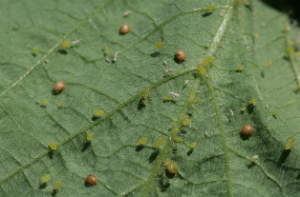Pests & Diseases Threaten Late-Planted Crops Across the State of Wisconsin

Soybean aphids on soybean leaf (image courtesy of www.soybeans.umn.edu)
A recent article from Agri-View reports pests and diseases are wreaking havoc on late-planted crops across the state of Wisconsin. Due to wet weather this planting season, growers are having to scout for early soybean aphid colonization, stripe rust, and Fusarium head blight (scab), among other epidemics.
According to recent surveys by the Wisconsin Department of Agriculture, Trade and Consumer Protection (DATCP), aphids have been spotted in 37% of fields sampled in the southern two-thirds of the state. Krista Hamilton, DATCP entomologist, claims the early colonization of the soybean aphid population this year means crop advisors and growers should institute a regular aphid-scouting program within the near future. Soybean growers are also warned to watch for beef leaf beetles, which could cause increased damage to crops as additional beetles migrate to emerging soybeans.
When it comes to corn crops, Hamilton claims European corn borer moth activity was expected to peak in the southern and central parts of the state last week. However, the migration of stalk borer larvae from weeds to corn is expected to accelerate this month, which Hamilton reports may require spot treatment if 10% of crops are infested. “As a reminder, most Bt corn hybrids will suppress but not completely control stalk borers, so field scouting is necessary through the V7 stage,” she points out.
Damon Smith, University of Wisconsin-Madison field crops pathologist, reports in the Agri-View article that stripe rust is present in parts of southern Wisconsin where winter wheat is flowering. While rust can result in yield reductions in some of these areas, Smith does not recommend using fungicide after flowering. “Continue scouting in areas in central and northern Wisconsin where wheat is flowering,” he advises. “If rust is noted in these locations where wheat has not flowered or is currently flowering, monitor severity on flag leaves and make a decision to apply a fungicide.”
In parts of southern Wisconsin, Smith also reportedly found several wheat heads with symptoms of Fusarium head blight (scab). According to Smith, growers are advised to check for presence of the disease in central and northern areas of Wisconsin by using the Fusarium head blight risk assessment tool.
As the summer wears on, growers in Wisconsin could be facing not only weather woes, but also the persistence of several pests and diseases, Agri-View reports.